Distance Learning during the COVID-19 Pandemic. A Comparison between European Countries
Abstract
:1. Introduction
1.1. Slovenia
1.2. Italy
2. Materials and Methods
3. Results
3.1. Descriptive Results
3.2. Perception of Distanced Learning
3.3. Relationship with Classmates, Peers, and Teachers
3.4. Levels of Stress and Anxiety
4. Discussion
4.1. Slovenia
4.2. Italy
4.3. Descriptive Comparison
5. Conclusions
Author Contributions
Funding
Institutional Review Board Statement
Informed Consent Statement
Data Availability Statement
Conflicts of Interest
References
- Bogoch, I.I.; Watts, A.; Thomas-Bachli, A.; Huber, C.; Kraemer, M.U.; Khan, K. Potential for global spread of a novel coronavirus from China. J. Travel Med. 2020, 27, taaa011. [Google Scholar] [CrossRef]
- MacIntyre, C.R. Global spread of COVID-19 and pandemic potential. Glob. Biosecurity 2020, 1. [Google Scholar] [CrossRef]
- Cruz, M.P.; Santos, E.; Cervantes, M.V.; Juárez, M.L. COVID-19, a worldwide public health emergency. Rev. Clínica Española Engl. Ed. 2021, 221, 55–61. [Google Scholar]
- Darby, A.C.; Hiscox, J.A. COVID-19: Variants and Vaccination; British Medical Journal Publishing Group: London, UK, 2021. [Google Scholar] [CrossRef]
- Venkatesan, P. NICE guideline on long COVID. Lancet Respir. Med. 2021, 9, 129. [Google Scholar] [CrossRef]
- Sudre, C.H.; Murray, B.; Varsavsky, T.; Graham, M.S.; Penfold, R.S.; Bowyer, R.C.; Pujol, J.C.; Klaser, K.; Antonelli, M.; Canas, L.S. Attributes and predictors of long COVID. Nat. Med. 2021, 27, 626–631. [Google Scholar] [CrossRef] [PubMed]
- Taylor, S. COVID stress syndrome: Clinical and nosological considerations. Curr. Psychiatry Rep. 2021, 23, 1–7. [Google Scholar] [CrossRef] [PubMed]
- McKibbin, W.; Fernando, R. The economic impact of COVID-19. Econ. Time COVID-19 2020, 45, 1162. [Google Scholar]
- Osofsky, J.D.; Osofsky, H.J.; Mamon, L.Y. Psychological and social impact of COVID-19. Psychol. Trauma: Theory Res. Pract. Policy 2020, 12, 468. [Google Scholar] [CrossRef] [PubMed]
- Sarkodie, S.A.; Owusu, P.A. Global assessment of environment, health and economic impact of the novel coronavirus (COVID-19). Environ. Dev. Sustain. 2021, 23, 5005–5015. [Google Scholar] [CrossRef] [PubMed]
- Verma, A.; Prakash, S. Impact of COVID-19 on environment and society. J. Glob. Biosci. 2020, 9, 7352–7363. [Google Scholar]
- Marinoni, G.; Van’t Land, H.; Jensen, T. The impact of COVID-19 on higher education around the world. In IAU Global Survey Report; 2020; Available online: https://www.iau-aiu.net/IMG/pdf/iau_covid19_and_he_survey_report_final_may_2020.pdf (accessed on 1 September 2021).
- Guessoum, S.B.; Lachal, J.; Radjack, R.; Carretier, E.; Minassian, S.; Benoit, L.; Moro, M.R. Adolescent psychiatric disorders during the COVID-19 pandemic and lockdown. Psychiatry Res. 2020, 291, 113264. [Google Scholar] [CrossRef]
- Mucci, F.; Mucci, N.; Diolaiuti, F. Lockdown and isolation: Psychological aspects of COVID-19 pandemic in the general population. Clin. Neuropsychiatry 2020, 17, 63–64. [Google Scholar]
- Raj, U.; Fatima, A. Stress in Students after Lockdown Due to COVID-19 Thereat and the Effects of Attending Online Classes. 2020. Available online: https://ssrn.com/abstract=3584220 (accessed on 1 July 2021).
- Manzar, M.D.; Albougami, A.; Usman, N.; Mamun, M.A. COVID-19 suicide among adolescents and youths during the lockdown: An exploratory study based on media reports. Suicide 2020. [Google Scholar] [CrossRef]
- Lage, A.; Carrapatoso, S.; Sampaio de Queiroz Neto, E.; Gomes, S.; Soares-Miranda, L.; Bohn, L. Associations Between Depressive Symptoms and Physical Activity Intensity in an Older Adult Population During COVID-19 Lockdown. Front. Psychol. 2021, 12, 1680. [Google Scholar] [CrossRef]
- Smith, L.E.; Amlot, R.; Lambert, H.; Oliver, I.; Robin, C.; Yardley, L.; Rubin, G.J. Factors associated with self-reported anxiety, depression, and general health during the UK lockdown; a cross-sectional survey. MedRxiv 2020. [Google Scholar] [CrossRef]
- Ferraro, F.V.; Ambra, F.I.; Aruta, L.; Iavarone, M.L. Students’ perception of distanced learning: A retrospective analysis. Eur. J. Res. Educ. Teach. 2021, 19, 533–543. [Google Scholar]
- Ferraro, F.V.; Ambra, F.I.; Aruta, L.; Iavarone, M.L. Distance Learning in the COVID-19 Era: Perceptions in Southern Italy. Educ. Sci. 2020, 10, 355. [Google Scholar] [CrossRef]
- Ambra, F.I.; Ferraro, F.V.; Aruta, L.; Iavarone, M.L. Distanced learning between educational and technological barriers A survey in the Campania region (Italy) with secondary school students. Attual. Pedagog. 2020, 2, 5–26. Available online: http://www.attualitapedagogiche.it/ojs/index.php/AP/issue/view/3/3 (accessed on 1 September 2021).
- Aruta, L.; Ambra, F.I.; Ferraro, F.V.; Iavarone, M.L. Bodytasking. Analysis and perceptions of a distanced dance experience. G. Ital. Educ. Alla Salut. Sport Didatt. Inclusiva 2021, 5, 46–58. [Google Scholar]
- Paloma, F.G. Embodied Cognitive Science: Atti Incarnati Della Didattica; Edizioni Nuova Cultura: Roma, Italy, 2013; Volume 1. [Google Scholar]
- Wilson, R.A.; Foglia, L. Embodied Cognition; Stanford Encyclopedia of Philosophy. Available online: https://plato.stanford.edu/ (accessed on 1 September 2021).
- Immordino-Yang, M.H.; Darling-Hammond, L.; Krone, C. The Brain Basis for Integrated Social, Emotional, and Academic Development: How Emotions and Social Relationships Drive Learning. Aspen Inst. 2018. [Google Scholar]
- Immordino-Yang, M.H.; Damasio, A. We feel, therefore we learn: The relevance of affective and social neuroscience to education. Mind Brain Educ. 2007, 1, 3–10. [Google Scholar] [CrossRef]
- Awal, M.R.; Cao, R.; Mitrovic, S.; Lee, R.K.-W. On analyzing antisocial behaviors amid COVID-19 pandemic. arXiv 2020, arXiv:2007.10712. [Google Scholar]
- Ragavan, M.I.; Culyba, A.J.; Muhammad, F.L.; Miller, E. Supporting adolescents and young adults exposed to or experiencing violence during the COVID-19 pandemic. J. Adolesc. Health 2020, 67, 18–20. [Google Scholar] [CrossRef] [PubMed]
- Engzell, P.; Frey, A.; Verhagen, M.D. Learning Inequality during the COVID-19 Pandemic. 2020, pp. 1–16. Available online: https://ideas.repec.org/p/osf/socarx/ve4z7.html (accessed on 1 September 2021).
- Vodičar, P.M.; Valenčak, A.O.; Zupan, B.; Županc, T.A.; Kurdija, S.; Korva, M.; Petrovec, M.; Demšar, J.; Knap, N.; Štrumbelj, E. Low prevalence of active COVID-19 in Slovenia: A nationwide population study of a probability-based sample. Clin. Microbiol. Infect. 2020, 26, 1514–1519. [Google Scholar] [CrossRef]
- Kodelja, Z. Šolstvo v času pandemije: Izobraževanje na daljavo. Sodob. Pedagog. 2020, 71, 42–56. [Google Scholar]
- Mikulec, B. Diskurz krize, pandemija covida-19 in izobraževanje odraslih. Sodob. Pedagog. 2020, 71, 112–119. [Google Scholar]
- Meherali, S.; Punjani, N.; Louie-Poon, S.; Abdul Rahim, K.; Das, J.K.; Salam, R.A.; Lassi, Z.S. Mental health of children and adolescents amidst COVID-19 and past pandemics: A rapid systematic review. Int. J. Environ. Res. Public Health 2021, 18, 3432. [Google Scholar] [CrossRef]
- Podlesek, A.; Kavcic, V. Generalised anxiety in Slovenian university students during the COVID-19 pandemic. J. Contemp. Educ. Stud./Sodob. Pedagog. 2021, 72, 322–341. [Google Scholar]
- Krajnc, Ž.; Huskić, A.; Kokol, Z.; Kos, T.; Košir, K. Attitudes, perceived competence, perceived support and stress in primary and upper-secondary school teachers and school counselors in the initial period of distance learning due to the COVID-19 epidemic. Sodob. Pedagog. J. Contemp. Educ. Stud. 2020, 71, 76–92. [Google Scholar]
- Krecenbaher Mernik, K. Poučevanje Tehnike in Tehnologije na Daljavo. Master’s Thesis, Faculty of Natural Sciences and Mathematics, University of Maribor, Maribor, Slovenia, 2020. [Google Scholar]
- Xerri, M. Addressing Child Poverty in the European Union. Bachelor’s Thesis, University of Malta, Msida, Malta, 2020. [Google Scholar]
- Eman, K.; Bulovec, T. A case study of rural crime and policing in Pomurje region in Slovenia. J. Rural Stud. 2021, 85, 43–51. [Google Scholar] [CrossRef]
- Yang, H.; Deng, P. The impact of COVID-19 and government intervention on stock markets of OECD countries. Asian Econ. Lett. 2021, 1, 18646. [Google Scholar]
- Rappleye, J.; Komatsu, H.; Uchida, Y.; Krys, K.; Markus, H. ‘Better policies for better lives’?: Constructive critique of the OECD’s (mis) measure of student well-being. J. Educ. Policy 2020, 35, 258–282. [Google Scholar] [CrossRef]
- Rossi, R.; Socci, V.; Talevi, D.; Mensi, S.; Niolu, C.; Pacitti, F.; Di Marco, A.; Rossi, A.; Siracusano, A.; Di Lorenzo, G. COVID-19 pandemic and lockdown measures impact on mental health among the general population in Italy. Front. Psychiatry 2020, 11, 790. [Google Scholar] [CrossRef]
- Pellegrini, M.; Maltinti, C. ‘School Never Stops’: Measures and Experience in Italian Schools during the COVID-19 Lockdown. Best Evid Chin Edu 2020, 5, 649–663. [Google Scholar] [CrossRef]
- Joulaei, H.; Zolfaghari, Z. COVID 19, School Closures, and its Complications. Int. J. Sch. Health 2021, 8, 1–2. [Google Scholar]
- Maltese, S. Non è una pandemia per giovani. Le adolescenze in stand-by e la metafora che non c’è. J. Health Care Educ. Pract. 2021, 3, 3–11. [Google Scholar]
- Iavarone, M.L.; Girardi, F. Povertà educativa e rischio minorile: Fenomenologia di un crimine sociale. Riv. Di Studi E Ric. Sulla Crim. Organ. 2018, 4, 23–44. [Google Scholar]
- Save The Children. Riscriviamo il futuro. In Rapporto Sui Primi Sei Mesi di Attività; Civitas Educationis. Education, Politics, and Culture; 2020; Volume 10, p. 32. Available online: https://universitypress.unisob.na.it/ojs/index.php/civitaseducationis/article/view/919 (accessed on 1 September 2021).
- Angeli, A. A Scuola di Cittadinanza Digitale; Booksprint: Rome, Italy, 2021. [Google Scholar]
- Ferraro, G. La Scuola dei Sentimenti: Dall’alfabetizzazione Delle Emozioni All’educazione Affettiva; Filema: Napoli, Italy, 2010. [Google Scholar]
- Iavarone, M.L.; Trocchia, N. Il Coraggio Delle Cicatrici: Storia di Mio Figlio Arturo e Della Nostra Lotta; Utet: Torino, Italy, 2020. [Google Scholar]
- Iavarone, M.L. Curare i margini. Riprendersi il senso dell’educazione per prevenire il rischio. Ann. Online Della Didatt. Della Form. Docente 2019, 11, 1–5. [Google Scholar]
- Ferraro, F.V.; Ambra, F.I.; Iavarone, M.L. Evaluation of Health-Habits with the S.M.A.R.T. Questionnaire: An Observational Study. Educ. Sci. 2020, 10, 285. [Google Scholar] [CrossRef]
- Symonds, E. A practical application of SurveyMonkey as a remote usability-testing tool. Libr. Hi Tech 2011, 436–445. [Google Scholar] [CrossRef]
- Iavarone, M.L.; Ferraro, F.V. Re-Thinking Learning Practices in the COVID-Era: Indications for Teachers and Educators. 2021. Available online: https://www.researchgate.net/publication/352172482_Re-thinking_learning_practices_in_the_Covid-era_indications_for_teachers_and_educators (accessed on 1 September 2021).
- Odoardi, I.; Furia, D.; Cascioli, P. Can social support compensate for missing family support? An examination of dropout rates in Italy. Reg. Sci. Policy Pract. 2021, 13, 121–139. [Google Scholar] [CrossRef]
- Ferraro, F.V.; de Ruggiero, F.; Marino, S.; Ferraro, G. Social Bottom-Up Approaches in Post-COVID-19 Scenario: The AGOGHÈ Project. Soc. Sci. 2021, 10, 274. [Google Scholar] [CrossRef]
- Balan, A.K.; Jacintos, A.R.; Montemayor, T. The Influence of Online Learning towards the Attention Span and Motivation of College Students. 2020. Available online: https://www.researchgate.net/publication/348916010_The_Influence_of_Online_Learning_towards_the_Attention_Span_and_Motivation_of_College_Students (accessed on 1 September 2021).
- Subramanian, K.R. Myth and mystery of shrinking attention span. Int. J. Trend Res. Dev. 2018, 5, 1–6. [Google Scholar]
- Kies, S.C. Social media impact on attention span. J. Manag. Eng. Integr. 2018, 11, 20–27. [Google Scholar]
- Kokoç, M. The mediating role of attention control in the link between multitasking with social media and academic performances among adolescents. Scand. J. Psychol. 2021, 62, 493–501. [Google Scholar] [CrossRef]
- Kant, R. Social Media: Attraction or Addiction? Asia Pac. J. Educ. Arts Sci. 2020, 7, 1–8. [Google Scholar]
- Sun, Y.; Zhang, Y. A review of theories and models applied in studies of social media addiction and implications for future research. Addict. Behav. 2020, 10, 106699. [Google Scholar] [CrossRef]
- Abi-Jaoude, E.; Naylor, K.T.; Pignatiello, A. Smartphones, social media use and youth mental health. CMAJ 2020, 192, E136–E141. [Google Scholar] [CrossRef] [Green Version]
- Alfaray, R.I.; Ibrahim, Y.; Faizun, R.S.A.; Irfana, L. Correlation between Social Media Addiction and Social Media Bullying: A Cross Sectional Analytic Study in Indonesian Youth. 2020, pp. 1–9. Available online: https://www.researchsquare.com/article/rs-14594/v1 (accessed on 1 September 2021).
- Soler-Costa, R.; Lafarga-Ostáriz, P.; Mauri-Medrano, M.; Moreno-Guerrero, A.-J. Netiquette: Ethic, Education, and Behavior on Internet—A Systematic Literature Review. Int. J. Environ. Res. Public Health 2021, 18, 1212. [Google Scholar] [CrossRef]
- Duh, M.; Krašna, M. Interactive e-learning materials: How to prepare and use it properly? In Proceedings of the 33rd International Convention MIPRO, Opatija, Croatia, 24–28 May 2010; pp. 833–836. [Google Scholar]
- Rajšp, P. Testna Anksioznost in Bralne Učne Strategije Pri Učencih s Primanjkljaji na Posameznih Področjih Učenja. Pedagoška Fakulteta, Univerza v Ljubljani. 2016. Available online: https://repozitorij.uni-lj.si/IzpisGradiva.php?id=83738&lang=slv&prip=dkum:10845061:d1 (accessed on 1 September 2021).
- Friškovec, T. Testna Anksioznost v Osnovni Šoli pri Pouku Matematike; Pedagoška Fakulteta, Univerza v Ljubljani: Ljubljana, Slovenia, 2016. [Google Scholar]
- Jusić, M. Testna Anksioznost u Obrazovanju. Novi Muall. 2010, 79–83. [Google Scholar]
- Kim, L.E.; Asbury, K. ‘Like a rug had been pulled from under you’: The impact of COVID-19 on teachers in England during the first six weeks of the UK lockdown. Br. J. Educ. Psychol. 2020, 90, 1062–1083. [Google Scholar] [CrossRef] [PubMed]
- Etheridge, B.; Tang, L.; Wang, Y. Worker productivity during lockdown and working from home: Evidence from self-reports. Covid Econ. 2020, 52, 118–151. [Google Scholar]
- Dockery, M.; Bawa, S. Working from Home in the COVID-19 Lockdown. Bentley Bankwest Curtin Econ. Cent. 2020, 19, 1–5. [Google Scholar]
- Balderas, A.; Caballero-Hernández, J.A. Analysis of Learning Records to Detect Student Cheating on Online Exams: Case Study during COVID-19 Pandemic. In Proceedings of the Eighth International Conference on Technological Ecosystems for Enhancing Multiculturality, Salamanca, Spain, 21–23 October 2020; pp. 752–757. [Google Scholar]
- Lucisano, P. Fare ricerca con gli insegnanti. I primi risultati dell’indagine nazionale SIRD “Per un confronto sulle modalitaà di didattica a distanza adottate nelle scuole italiane nel periodo di emergenza COVID-19”. Lifelong Lifewide Learn. 2020, 16, 3–25. [Google Scholar]
- Cook, D.A.; Dupras, D.M. A practical guide to developing effective web-based learning. J. Gen. Intern. Med. 2004, 19, 698–707. [Google Scholar] [CrossRef]
- Twenge, J.M.; Spitzberg, B.H.; Campbell, W.K. Less in-person social interaction with peers among US adolescents in the 21st century and links to loneliness. J. Soc. Pers. Relatsh. 2019, 36, 1892–1913. [Google Scholar] [CrossRef]
- Thomas, L.; Orme, E.; Kerrigan, F. Student loneliness: The role of social media through life transitions. Comput. Educ. 2020, 146, 103754. [Google Scholar] [CrossRef]
- Anouna, J. Social Media: A New Tool for Peacebuilding in Italy. 2020, pp. 1–15. Available online: https://www.repository.cam.ac.uk/handle/1810/304793 (accessed on 1 September 2021).
- La Rocca, G. Social Bullying Un’analisi Delle Recenti Pratiche Di Diffusione Degli Atti Di Bullismo. Studi Sociol. 2017, 55, 195–210. [Google Scholar]
- Rajamohan, S.; Bennett, E.; Tedone, D. The hazards and benefits of social media use in adolescents. Nursing 2019, 49, 52–56. [Google Scholar] [CrossRef]
- Albonetti, S.; Ratti, M.M.; Rossoni, L. Violenza Minorile, Bullismo e Cyberbullismo: Gruppi Formativi a Mediazione Tra Psicologia e Diritto; FrancoAngeli: Roma, Italy, 2020. [Google Scholar]
- Chomsky, N.; Foucault, M. The Chomsky-Foucault Debate: On Human Nature; The New Press: New York, NY, USA, 2015. [Google Scholar]
- Alvarez, A.V., Jr. Rethinking the digital divide in the time of crisis. Glob. J. Progress. Educ. 2021, 11, 26–28. [Google Scholar]
 Male,
Male,  Female.
Female.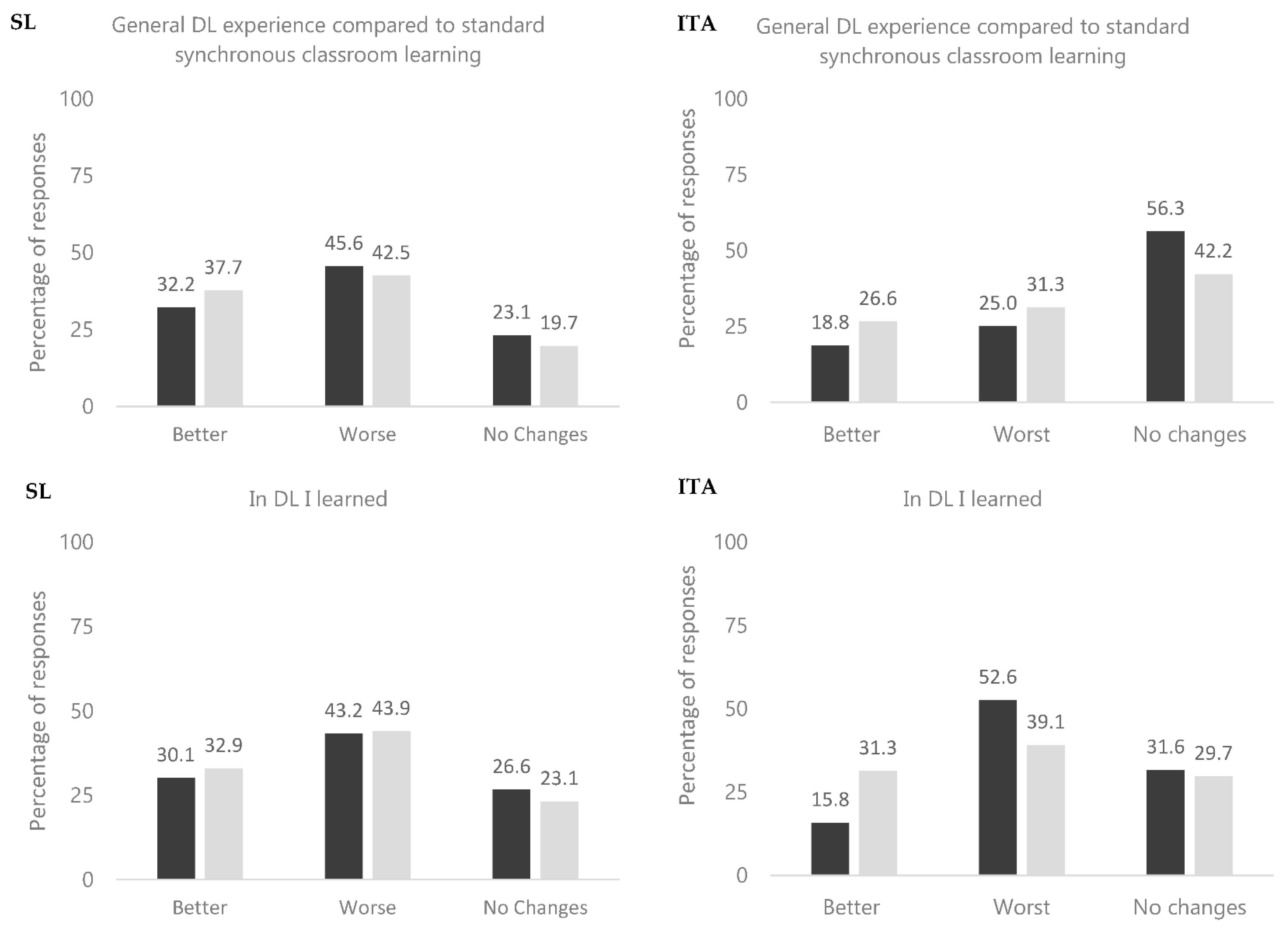
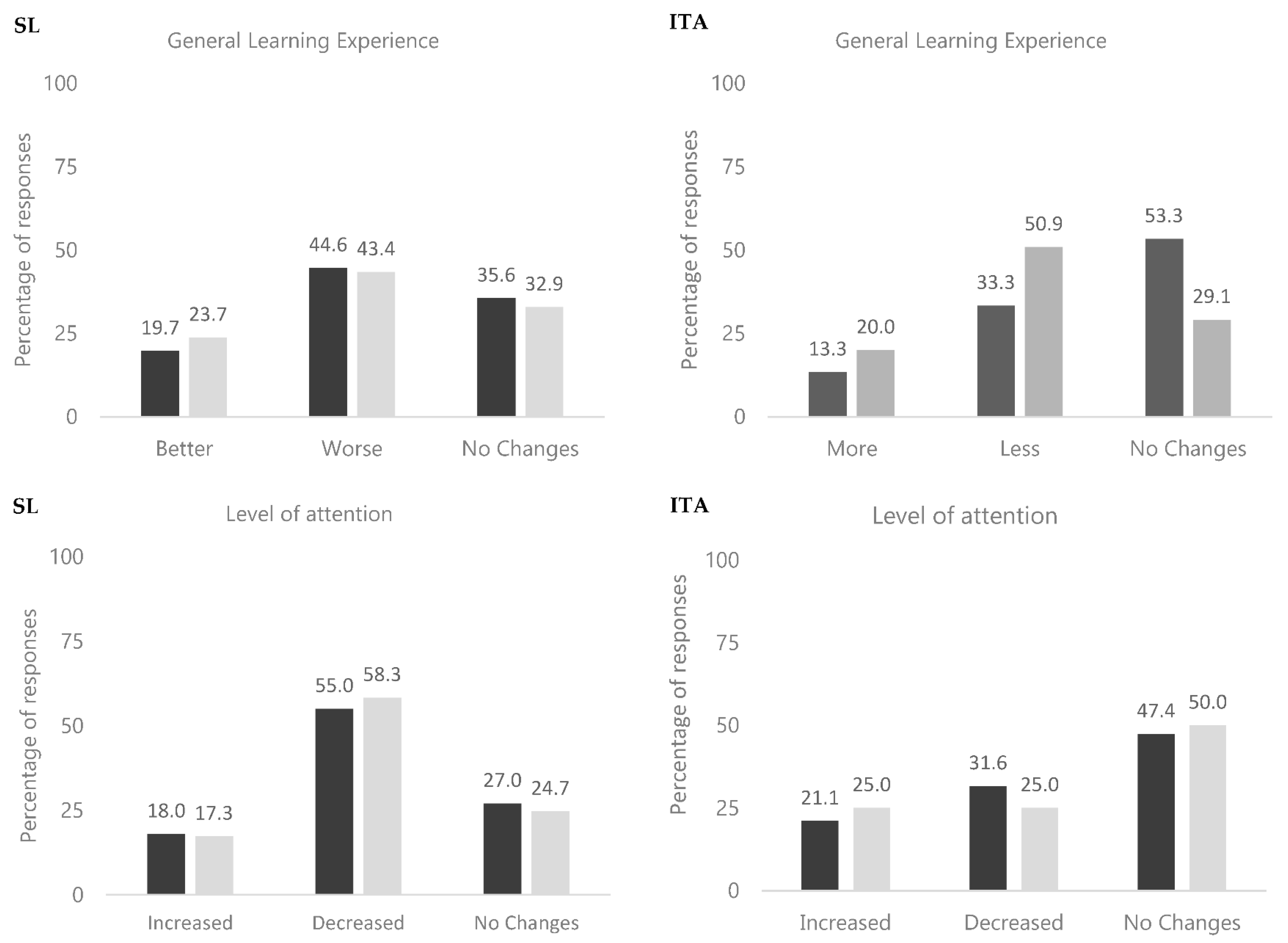
 Male,
Male,  Female.
Female.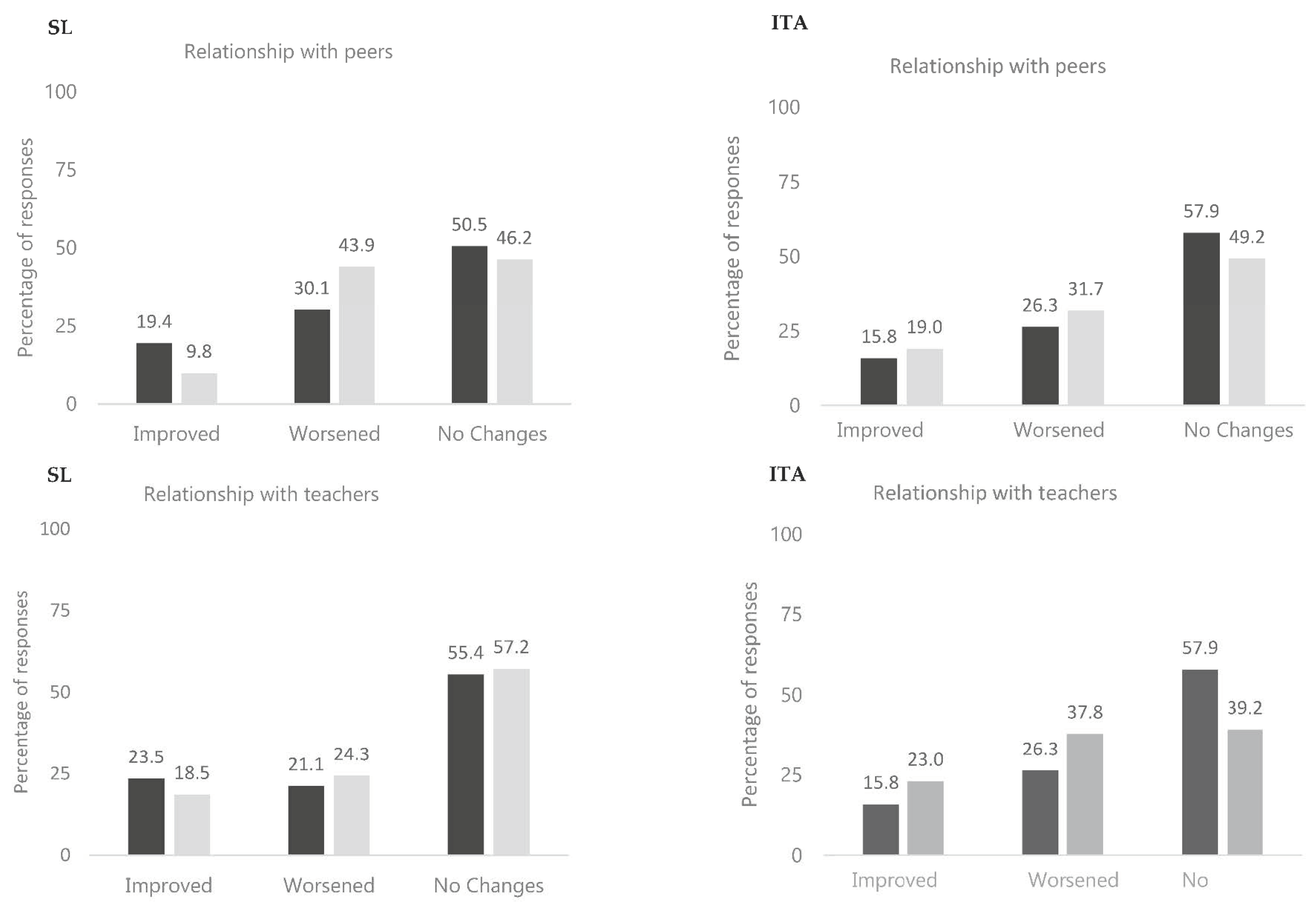
 Male,
Male,  Female.
Female.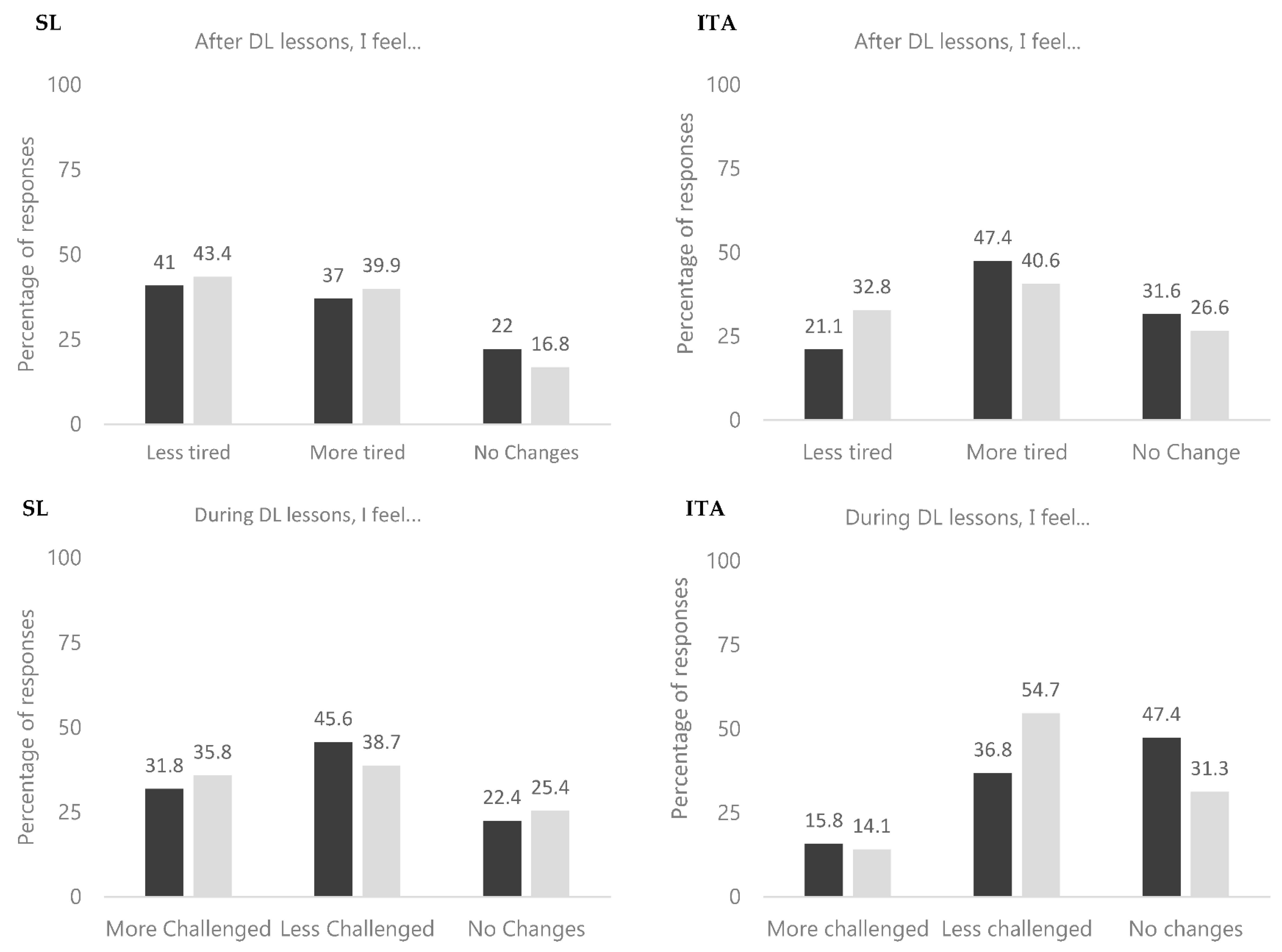
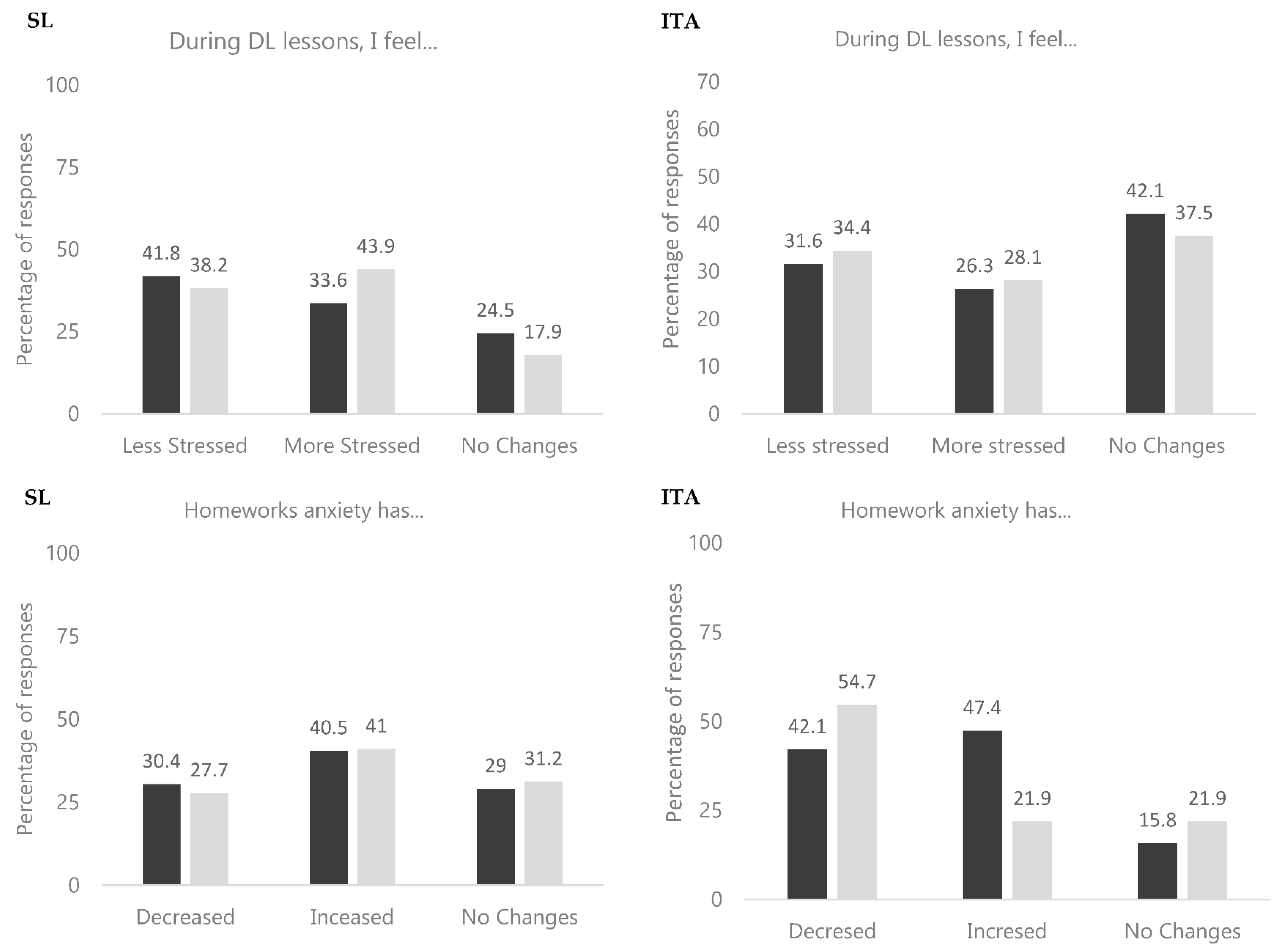
| Questions | Answer |
|---|---|
| 1. How old are you? | <<open answer>> |
| 2. What gender do you identify with? | <<open answer>> |
| 3. Which educational institution do you study at? | <<open answer>> |
| 4. What year are you in? | <<open answer>> |
| 5. Do you have your own computer? | <<open answer>> |
| 6. Which device do you use for distance learning/video conferencing? | <<open answer>> |
| 7. In which room do you watch lectures/video conferences? | <<open answer>> |
| 8. Do you always watch lectures/video conferences from the same room? | <<open answer>> |
| 9. What software do you use to monitor lectures/video conferences? | <<open answer>> |
| 10. How many lectures/video conferences do you watch online daily per day? | <<open answer>> |
| 11. How many hours a day? | <<open answer>> |
| 12. Do you have brothers and/or sisters? * | <<open answer>> |
| 13. How many siblings do you have? * | <<open answer>> |
| 14. Do you share a computer with them that you use for distance learning/watching lectures and video conferencing? * | <<open answer>> |
| 15. Do you eat snacks or other harmful food during distance learning/watching lectures and video conferencing, which you would not normally do if you would be present to the lectures in class? * | <<open answer>> |
| 16. What is your general experience with distance learning compared to classroom teaching? | <<open answer>> |
| 17. Do I learn by distance learning… | Better/worse/no change |
| 18. Have I experienced distance learning in general… | More inclusive/less inclusive/no change |
| 19. With distance learning has my attention… | Increased/decreased/no change |
| 20. With distance learning, the relationship with my classmates and peers has… | Improved/deteriorated/no change |
| 21. By distance learning my relationship with teachers is now… | Better/worse/no change |
| 22. After distance learning lectures I feel… | Less tired/more tired/no change |
| 23. Remote lectures/videoconferences are for me… | A bigger challenge/a smaller challenge/no changes |
| 24. With distance learning I feel…. | More stressed/less stressed/no change |
| 25. With distance learning, my anxiety with learning and homework has… | Decreased/increased/no change |
| 26. What do you like most about distance learning? * | <<open answer>> |
| 27. What do you like least about distance learning? * | <<open answer>> |
| Answer | Percentage in Slovenia | Percentage in Italy |
|---|---|---|
| Which device do you use for distance learning/video conferencing? | ||
| Computer | 70.3 | 42.4 |
| Smart phone/tablet | 28.0 | 56.5 |
| Other device | 1.7 | 1.1 |
| From where do you participate in lectures/videoconferences? | ||
| From own room | 72.7 | 68.7 |
| From different room | 27.3 | 30.1 |
| What software do you use to monitor lectures/videoconferences? | ||
| Zoom | 55.8 | 25.3 |
| Cisco | 0.2 | 2.4 |
| Skype | 0 | 19.3 |
| Microsoft Teams | 41.3 | 6.0 |
| 0.4 | 26.5 | |
| Other | 2.3 | 20.5 |
| Do you have siblings? | ||
| Yes | 86.2 | 66.7 |
| No | 13.8 | 33.3 |
| How many siblings do you have? | ||
| 0 | 10.7 | N/A |
| 1 | 47.8 | N/A |
| 2 | 24.0 | N/A |
| 3 | 9.0 | N/A |
| 4 | 2.1 | N/A |
| 5 | 0.6 | N/A |
| 6 | 1.0 | N/A |
| More than 6 | 4.8 | N/A |
| Do you share with them the computer you use for distance learning/watching lectures and video conferencing? | ||
| Yes | 15.9 | 58.7 |
| No | 83.3 | 41.3 |
| No answer | 0.8 | 0.0 |
| Do you enjoy snacks or other unhealthy food during distance learning? | ||
| Yes | 45.5 | N/A |
| No | 54.3 | N/A |
| No answer | 0.2 | N/A |
| Answer | Percentage in Slovenia | Percentage in Italy |
|---|---|---|
| Number of lectures/videoconferences per day | ||
| 1 | 1.0 | 1.2 |
| 2 | 5.6 | 0.0 |
| 3 | 26.5 | 0.0 |
| 4 | 30.9 | 7.2 |
| 5 | 20.0 | 14.5 |
| 6 | 8.4 | 20.5 |
| 7 | 4.6 | 24.1 |
| 8 | 1.7 | 24.1 |
| More than 8 | 1.3 | 16.8 |
| No. hours of monitoring (h) | ||
| 1 | 2.3 | 3.6 |
| 2 | 7.5 | 10.8 |
| 3 | 15.9 | 42.2 |
| 4 | 27.8 | 34.9 |
| 5 | 18.8 | 20.5 |
| 6 | 12.5 | 1.2 |
| 7 | 8.5 | 0.0 |
| 8 | 4.8 | 2.4 |
| What Do You Like about Distance Learning? | Percentage |
|---|---|
| No getting up early/I can sleep longer | 19.6 |
| No answer | 16.3 |
| No trip to school/I can stay at home | 14.0 |
| Independent scheduling of time/work | 11.7 |
| I do not like anything about it | 11.1 |
| More free time/more learning time | 9.6 |
| It is easier | 3.8 |
| Everything | 3.3 |
| I can follow the lessons more comfortably (e.g., better chair, adjustment of volume, no disturbance from classmates) | 1.9 |
| There are no social contacts/I am not with classmates who bully | 0.8 |
| To prevent infections | 0.4 |
| Other | 7.5 |
| What You Did Not Like about Distanced Learning | Percentage |
|---|---|
| No reply | 22.1 |
| No contact/no lessons at school, video conferencing, no physical activity, being at home, etc. | 14.4 |
| Poor organization by lecturers, schools, unwillingness of lecturers, non-participation of classmates. | 12.5 |
| Everything | 8.1 |
| Nothing | 7.5 |
| Less attention in class/lack of motivation, fatigue. | 6.5 |
| More homework | 5.9 |
| Too many electronic devices/problems with them. | 4.8 |
| Fear of inferior knowledge. | 4.4 |
| No practice | 2.9 |
| Assessment methods | 2.5 |
| Too much learning content to comprehend | 1.7 |
| Other | 6.7 |
Publisher’s Note: MDPI stays neutral with regard to jurisdictional claims in published maps and institutional affiliations. |
© 2021 by the authors. Licensee MDPI, Basel, Switzerland. This article is an open access article distributed under the terms and conditions of the Creative Commons Attribution (CC BY) license (https://creativecommons.org/licenses/by/4.0/).
Share and Cite
Katić, S.; Ferraro, F.V.; Ambra, F.I.; Iavarone, M.L. Distance Learning during the COVID-19 Pandemic. A Comparison between European Countries. Educ. Sci. 2021, 11, 595. https://doi.org/10.3390/educsci11100595
Katić S, Ferraro FV, Ambra FI, Iavarone ML. Distance Learning during the COVID-19 Pandemic. A Comparison between European Countries. Education Sciences. 2021; 11(10):595. https://doi.org/10.3390/educsci11100595
Chicago/Turabian StyleKatić, Sandra, Francesco V. Ferraro, Ferdinando Ivano Ambra, and Maria Luisa Iavarone. 2021. "Distance Learning during the COVID-19 Pandemic. A Comparison between European Countries" Education Sciences 11, no. 10: 595. https://doi.org/10.3390/educsci11100595
APA StyleKatić, S., Ferraro, F. V., Ambra, F. I., & Iavarone, M. L. (2021). Distance Learning during the COVID-19 Pandemic. A Comparison between European Countries. Education Sciences, 11(10), 595. https://doi.org/10.3390/educsci11100595






